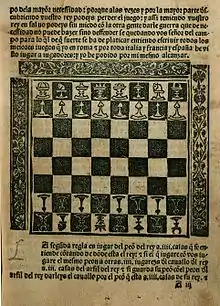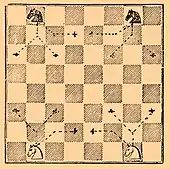A chess diagram is graphic representation of a position in a chess game, using standardised symbols. Chess diagrams are widely used in chess publications as an aid to visualisation, or to aid the readers to verify that they are looking at the correct position on their chessboard or computer. The symbols used generally resemble the pieces of the standard Staunton chess set, although a number of different fonts have been used over the centuries.
| a | b | c | d | e | f | g | h | ||
| 8 |  | 8 | |||||||
| 7 | 7 | ||||||||
| 6 | 6 | ||||||||
| 5 | 5 | ||||||||
| 4 | 4 | ||||||||
| 3 | 3 | ||||||||
| 2 | 2 | ||||||||
| 1 | 1 | ||||||||
| a | b | c | d | e | f | g | h | ||
This diagram shows the opening position in a game of chess.
Forsyth-Edwards Notation (FEN) can be used to represent a position without graphics, i.e. with letters and numbers only.
Examples
 Lucena (1497)
Lucena (1497)_b_464.jpg.webp) Die Gartenlaube (1860)
Die Gartenlaube (1860) Through the Looking Glass by Lewis Carroll (1871)
Through the Looking Glass by Lewis Carroll (1871) Brockhaus and Efron Encyclopedic Dictionary (1890-1907)
Brockhaus and Efron Encyclopedic Dictionary (1890-1907) Page from a Soviet calendar (1935)
Page from a Soviet calendar (1935)
Further reading
- Hooper, David; Whyld, Kenneth (1992), The Oxford Companion to Chess (2nd ed.), Oxford University Press, p. 108, ISBN 0-19-280049-3
External links
This article is issued from Wikipedia. The text is licensed under Creative Commons - Attribution - Sharealike. Additional terms may apply for the media files.